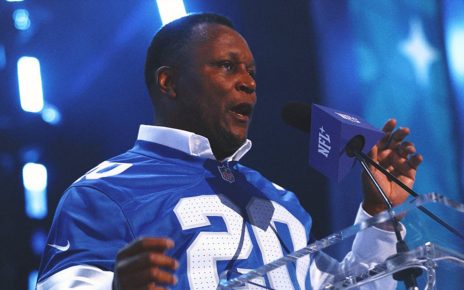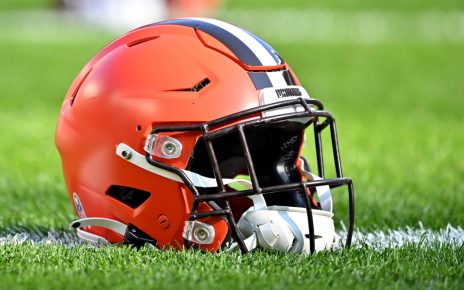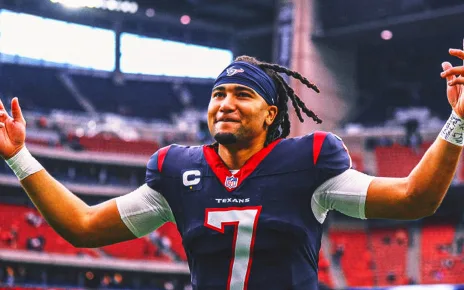$Signed a five-year, $100 million contract with the Cowboys in March of 2020. Traded to the Browns in March of 2022.
Unbothered by playing most of the season with the mediocre Jacoby Brissett as his quarterback, Cooper enjoyed a rebound season in 2022 after a slow finish to his three-and-a-half-year tenure in Dallas. Nine touchdowns represented a career high, with 132 targets tying his previous best and 1,160 yards marking his second most. Cooper has never quite been the high-end WR1 many expected when the Raiders made him the fourth overall pick in 2015, but he does have six 1,000-yard campaigns in nine years and has never scored fewer than five touchdowns in a season. One concern from last year is that he actually put up better numbers with Brissett than with Deshaun Watson, though it didn’t help that four of the six Watson games were December/January home contests in Cleveland, where wind tends to be a bigger factor than in any NFL locale. The Browns have other weapons in TE David Njoku, WR Donovan Peoples-Jones and offseason addition Elijah Moore, but only Moore has shown potential to threaten the volume of someone like Cooper … and Moore is coming off a complete bust of a second season in New York. The greater concern is that Watson didn’t look like his old self last year.
Cooper has played seven seasons, missing only five games, and now has been traded twice
prior to turning 28 (which he did in June). He’s topped 1,000 yards five times, with no less than
five TDs and no more than eight in any season, but few would describe him as consistent. A
couple years back, that was largely due to a history of mixing a few massive stat lines with a
larger number of duds. The week-to-week inconsistency subsided the last two seasons in
Dallas, but it’s hard to frame that as a good thing on the heels of a 2021 campaign where
Cooper largely posted mediocre receiving lines after peaking at 13-139-2 in Week 1. Nagging
injuries might have played a role, though he missed just two games, and he dropped from 8.1
targets per game in 2020 to 6.9 in 2021. A March trade to Cleveland leaves Cooper with less
competition for targets than what he had in Dallas. The Browns hope they won’t need a deep
wideout group, with new franchise QB Deshaun Watson backed by a top-10 offensive line and
one of the best backfields in the league. It’s a pretty good situation for Cooper, though one with
some risk, especially after his play slipped a bit his final year in Dallas and with Watson facing an 11-game suspension.
Cooper had a fine season despite missing his starting quarterback most of last year. He managed 8.6 YPT (14th among the league’s 35 100-target receivers) and caught 92 passes (T-9th). He also saw a fair amount of work from in close – nine targets from inside the 10 and seven from inside the five (T-8th). At 6-1, 210, Cooper is big, physical and runs well (4.42 40). He’s able to make plays downfield (three catches of 40-plus yards last year, six in 2019), and he’s had three 200-yard receiving games in his career. And having Dak Prescott back should benefit the entire passing offense. The biggest negative for Cooper is his competition for targets. Last year’s first-round pick CeeDee Lamb had 111 targets, and fourth-year man Michael Gallup, another deep threat, had 105. Lamb is as likely as Cooper to lead the team in looks in 2021, something that caps Cooper’s ceiling. Cooper underwent ankle surgery in January and was placed on the PUP list for the start of training camp, but the Cowboys expect him to be ready for practice by mid-August and ready for games by Week 1.
People mocked Jerry Jones for giving up a first-round pick to acquire a slumping Cooper in 2018, but Cooper has been worth that and more. In his first full season as a Cowboy, he managed 15.1 YPC (8th) and 10.0 YPT (3rd). He had six catches of 40-plus yards (T-6th) and scored eight touchdowns (T-12th) despite seeing only 119 targets (18th) and nine looks in the red zone. At 6-1, 210, and with 4.42 speed, Cooper has the size to overpower smaller defensive backs and the speed to get down the field. Moreover, since Cooper’s arrival, Cowboys quarterback Dak Prescott went from being a competent game manager to one of the league’s leading passers. And Cooper, who signed a five-year, $100 million contract with the Cowboys in March, is just 26 years old and still firmly in the prime of his career. Third-year man Michael Gallup (113 targets in 14 games) actually saw more targets per game than Cooper, and the team drafted super prospect CeeDee Lamb with the 17th overall pick, so Cooper’s not the only show in town. Fortunately, Randall Cobb (83 targets) left for Houston, and Prescott was sixth in the league in attempts last year, so there’s enough to go around for all three players. And both Gallup and Cooper should see an uptick in red-zone targets under new coach Mike McCarthy.
A first-round pick seemed like a steep price for Cooper’s services midseason, but the Cowboys more than got their money’s worth over the last nine games. Cooper posted a 76-53-725-6 line in Dallas after the trade, numbers that prorate to 135-94-1,289-11 over a full season. His arrival also seemed to jump-start the entire Dallas offense, as quarterback Dak Prescott looked like a different player with Cooper on the field. At 6-1, 210, Cooper has decent size and good speed (4.42 40) and was the Raiders’ main big-play weapon his first two years in the league. Cooper’s average depth of target (9.4 overall) dropped with the Cowboys, but he caught 70 percent of the passes thrown his way for 9.5 YPT, a number that would have placed him at seventh among 100-target wideouts. Cooper didn’t see much overall red-zone work in Dallas (only nine targets inside the 20), but his five inside-the-10 looks (for one TD) in nine games bode well for 2019 when he’ll return as the team’s unquestioned top target. Second-year man Michael Gallup showed flashes as a rookie, but he lacks Cooper’s downfield explosiveness and profiles more as a complement than a threat to Cooper’s role.
2017 was a lost season for Cooper, who dropped passes, missed two games with an ankle injury and generally looked lost in a subpar Raiders offense all year. With the exception of Week 17, which doesn’t count in most fantasy leagues, Cooper had only one game in which he exceeded 70 yards and five in which he failed to have even 10. His season totals were bolstered by that Week 17 game (115 yards and a TD), and his other good game was a monstrous 11-210-2 outburst against the Chiefs, but having him in the lineup week in and week out was costly, even in a down year for receivers generally. At 6-0, 211, and with a 4.42 40, Cooper has good size and speed, though he’s hardly a freak in the mold of Julio Jones or Josh Gordon. Cooper has never been much of a red-zone target, with most of that work going to teammate Michael Crabtree. This year, Crabtree will ply his trade in Baltimore, so Cooper could see more looks in that area, though the Raiders acquired sure-handed Jordy Nelson (6-3, 217) a big targets who might be better suited for it. But Nelson is 33 and new coach Jon Gruden indicated Cooper will be “the focal point” of the team’s offense. Accordingly, expect a target spike at the very least, and keep in mind Cooper is still only 24.
What is Derek Carr’s obsession with Michael Crabtree? For the second year in a row, the ineffective Crabtree (6.9 YPT, 33rd) saw more looks (145) than Cooper (8.7 YPT, 13th) did (132), especially in the red zone where Crabtree got 21 targets to Cooper’s 13. While Cooper gained 150 more yards despite the lower volume, Crabtree outscored him eight to five. At 6-1, 211 and with 4.43 speed, Cooper is a nice blend of size and game-breaking speed. He’s also quick and athletic and runs crisp routes. While Cooper had only two catches of 40-plus, he brought in 21 of 20-plus (4th) despite being 15th in targets. The question for Cooper once again is volume — his skills and role make him a safe bet to reach 1,000 yards and half a dozen TDs, but his ceiling is limited by Crabtree’s heavier workload, especially from in close. Adding insult to injury, slot man Seth Roberts also saw a whopping 21 of his 77 targets in the red zone, effectively freezing Cooper out, though we’d expect significant regression on that front. The Raiders didn’t make any significant additions to the passing offense — Jared Cook figures to be a lowend tight end, and Cordarrelle Patterson more of a return man than a source of targets, so it’s still possible Cooper claims his rightful share of the team’s aerial output. Even if he doesn’t, the floor is still high for the 23-year old.
Cooper’s rookie year was more or less what one would expect. While he eclipsed 1,000 receiving yards, making him only the 15th rookie to do so since the merger, he scored only six times, and his 8.2 YPT placed him 16th among the league’s 32 100-target wide receivers. But perhaps the bigger surprise was Cooper not being the top target on his own team. Despite playing all 16 games, he finished with 16 fewer targets than Michael Crabtree, a castoff from the 49ers whose career seemed on its last legs. At 6-1, 211, Cooper has decent size, and his 4.42 40 time is above average. He’s a strong route-runner, quick in and out of breaks and willing to go over the middle of the field. He also makes big plays — his six catches for 40-plus yards tied for sixth in the league, even though he was only 16th in targets. Heading into 2016, Cooper should supplant Crabtree as the team’s target leader. Receivers typically make dramatic improvements in their second seasons, and while David Carr is no Drew Brees, he is a competent quarterback who should also get better in Year 3 as his rapport with Cooper grows.
The fourth overall pick in this year’s draft, Cooper won’t hurt for opportunities in Oakland. The question is of what quality. While some are excited about quarterback Derek Carr’s 21-TD, 12-INT rookie season, it came with a 5.5 YPA, last by a wide margin among the 36 quarterbacks with 200 or more pass attempts. To be sure, Cooper should be an immediate upgrade over Carr’s targets from last season, and it’s likely he’ll be the team’s clear No. 1 out of the gate even with newly signed Michael Crabtree around. But this is a bottom-of-the-barrel organization trying to improve a passing game that ranked 26th in yards and last in efficiency. Cooper himself is an interesting prospect because for such an early pick he lacks the elite size/speed profile of an A.J. Green or Julio Jones. But at 6-1, 211, he’s above average in height and weight, and his 4.42 40 is fast, just not blazingly so. Cooper’s especially polished as a route-runner, quick and fluid in and out of breaks and willing to take hits and catch balls in traffic. And he was massively productive in college. But while some have compared him to Marvin Harrison, no one is comparing his quarterback to Peyton Manning.



